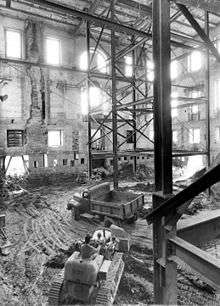Renovation

Renovation (also called remodeling) is the process of improving a broken, damaged, or outdated structure. Renovations are typically either commercial or residential. Additionally, renovation can refer to making something new, or bringing something back to life and can apply in social contexts. For example, a community can be renovated if it is strengthened and revived.[1]
Process
The renovation process can usually be broken down into several processes:
- Planning
- Engineering
- Structural repair
- Rebuilding
- Finishes
Reasons
Many people renovate homes to create a new appearance for their home, or so another person can live in the residence.[2] Builders often renovate homes because it is a stable source of income.[3]
Wood and renovations
Wood is versatile and flexible, making it the easiest construction material for renovations, and wood buildings can be redesigned to suit changing needs. Few homeowners or professional remodellers possess the skill and equipment that is required to alter steel-frame or concrete structures.
Forest certification verifies that wood products have been sourced from well-managed forests. Most certification programs provide online search options so that consumers can find certified products—the Certification Canada program includes a search option for all of the certification programs that are in use in Canada.[4]
In North America, most structures are demolished because of external forces such as zoning changes and rising land values. Additionally, buildings that cannot be modified to serve the functional needs of the occupants are subject to demolition. Very few buildings on the continent are demolished due to structural degradation.[5]
The Athena Institute surveyed 227 commercial and residential buildings that were demolished in St. Paul, Minnesota, between 2000 and mid-2003. Thirty percent of the buildings were less than 50 years old, and 6% were less than 25 years old. The four top reasons for demolition were “area redevelopment” (35%), “building’s physical condition” (31%), “not suitable for anticipated use” (22%), and “fire damage” (7%). Lack of maintenance was cited as the specific problem for 54 of the 70 buildings where physical condition was given as the reason for demolition.[5]
Process
Most builders focus on building new homes, so renovating is typically a part-time activity for such tradespeople. The processes and services required for renovations are quite specific and, once plans are signed off, building a new home is relatively predictable. Renovations usually require all of the sub-trades that are needed for the construction of a new building. During renovation projects, flexibility is often required from renovation companies to respond to unexpected issues that arise. Projects involving renovation require not just flexibility, but a plan that had been agreed upon by multiple parties. The planning process will involve feedback from financial investors of the project, and from the designer. Part of planning will also entail the collection of data for the completion of the project and then the project plan will be revised and given consent before continuing with renovations.[6]
Effects

Renovation has several impacts, including:[7]
- creating jobs
- increasing spending
- promoting gentrification
- generating Tax revenue during both the construction and residential phases
Requirements
Requirements for renovation include property or site to reconstruct; structural plans; knowledge of sewage disposal, water supply, and flood zones; project plan; funding; and builders.
See also
References
- ↑ "Renovate". Merriam-Webster Dictionary. Merriam-Webster, Incorporated. October 2013. Retrieved 3 October 2013.
- ↑ "Kitchen Remodel: 101 Stunning Ideas for Your Kitchen Design". Decoist Magazine. Retrieved 2 August 2014.
- ↑ Harvey, C. (2012). Renovate or sell? Builders, homeowners opt for remodeling investment. Business Journal Serving Fresno & The Central San Joaquin Valley, 1-5.
- ↑ Certification Canada (2012). "Certification status - Canada & the globe". Certification Canada. FPAC. Retrieved 2 July 2012.
- 1 2 The Athena Institute (February 2004). "MINNESOTA DEMOLITION SURVEY: PHASE TWO REPORT" (PDF). Minnesota Demolition Survey: Phase Two Report. Forintek Canada Corp. Retrieved 20 June 2013.
- ↑ "Feasibility Study for the Academy Building Renovation and Town Hall and Memorial Building Reuse" (PDF). Bridgewater, Massachusetts. 15 August 2012. Retrieved 2 August 2014.
- ↑ "Foundations for future growth in the Remodeling Industry" (PDF). Joint Center for Housing Studies of Harvard University. 2007. Retrieved 2 August 2014.